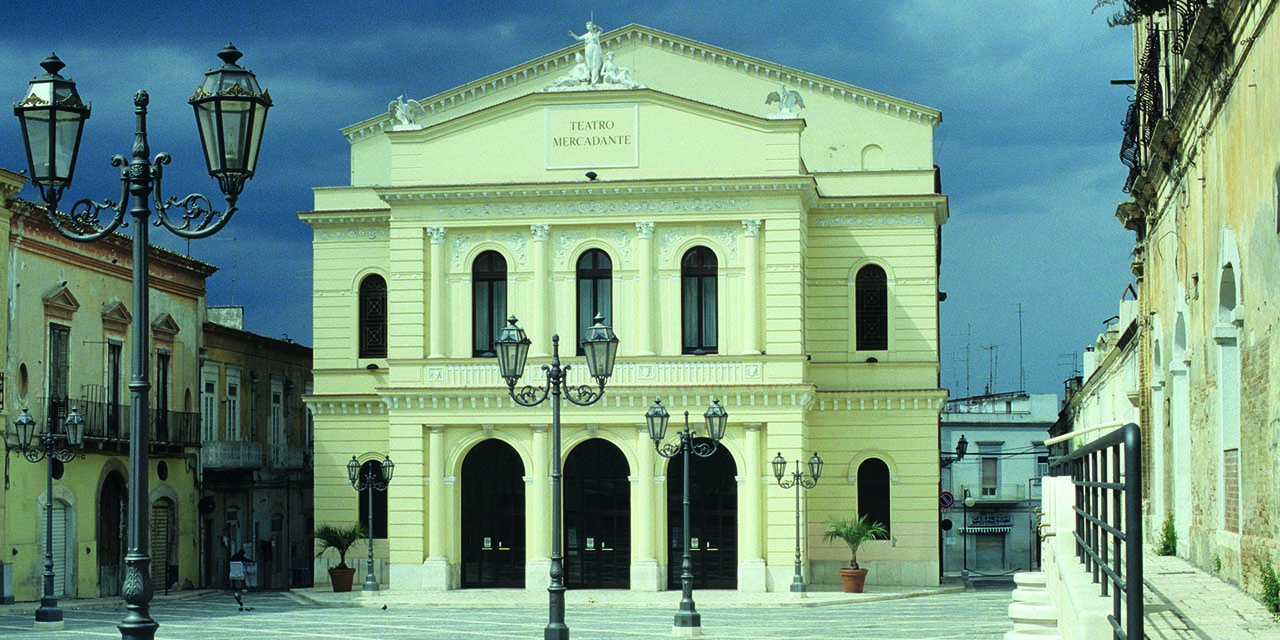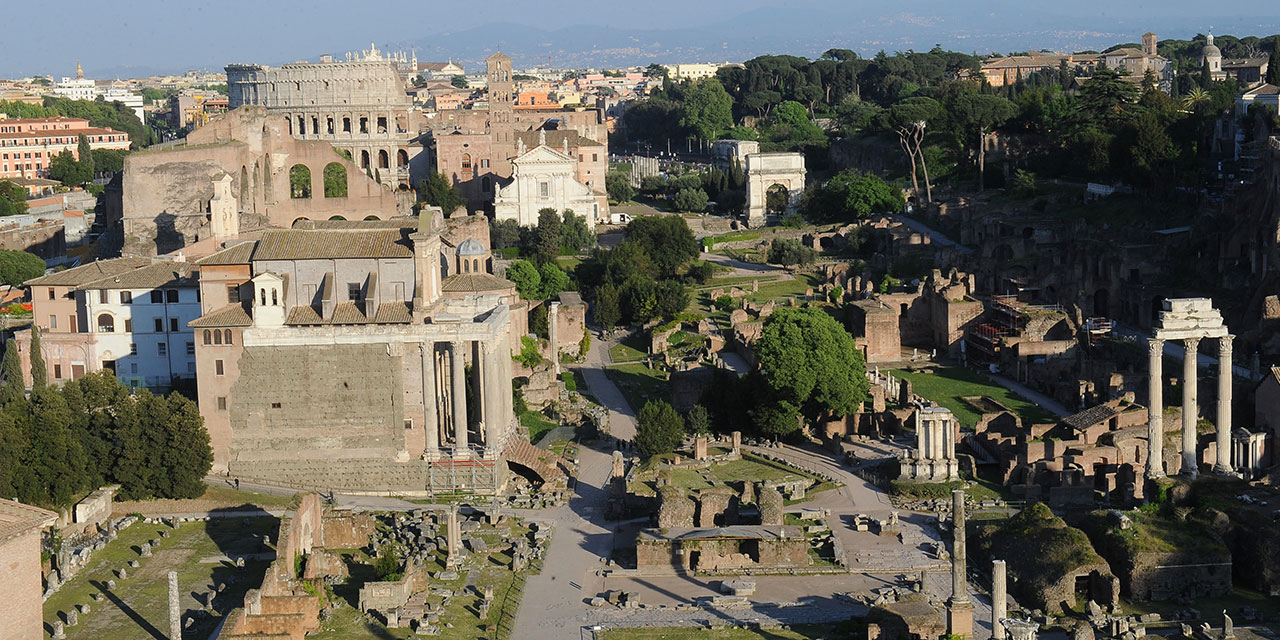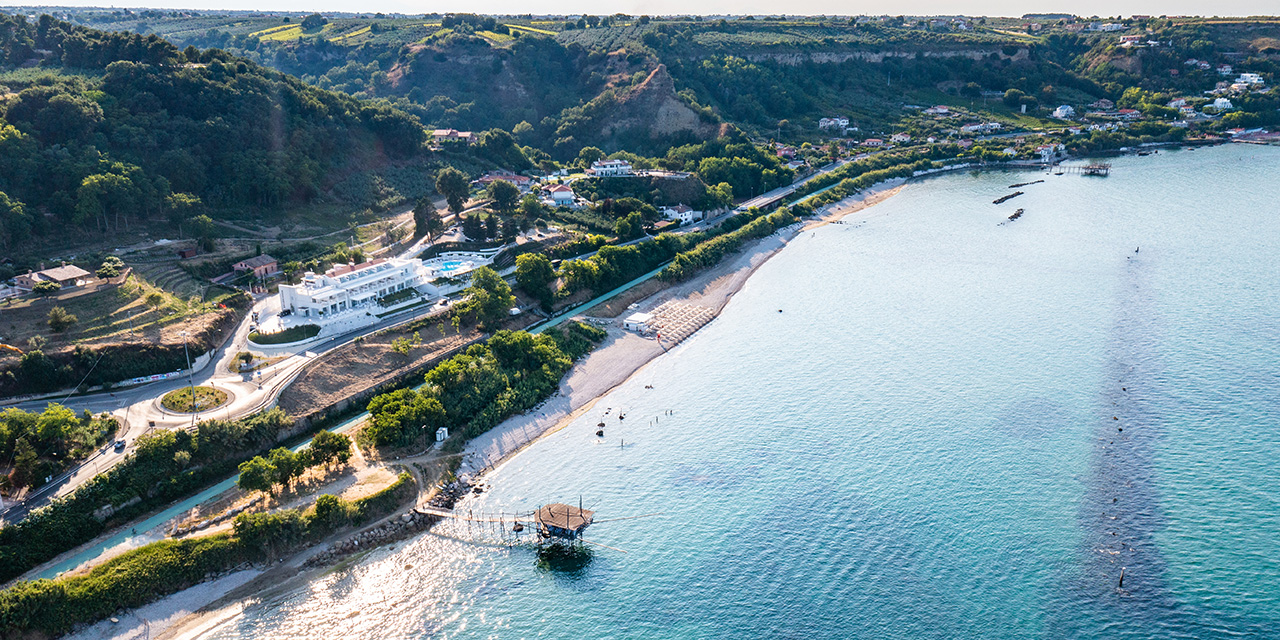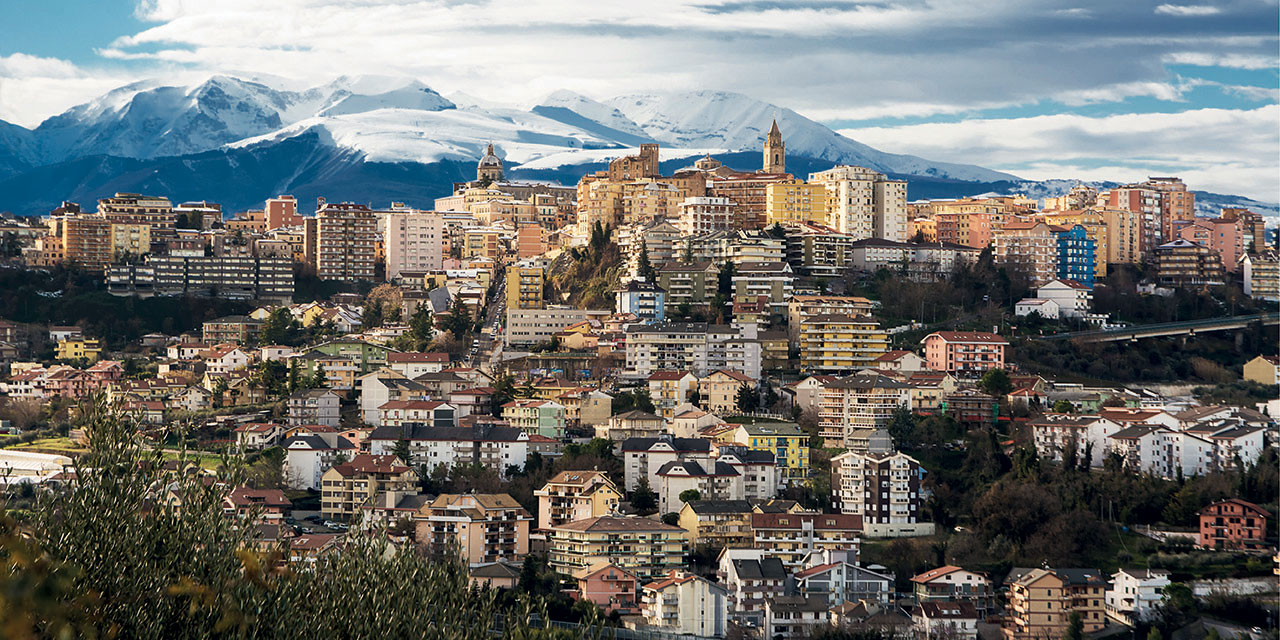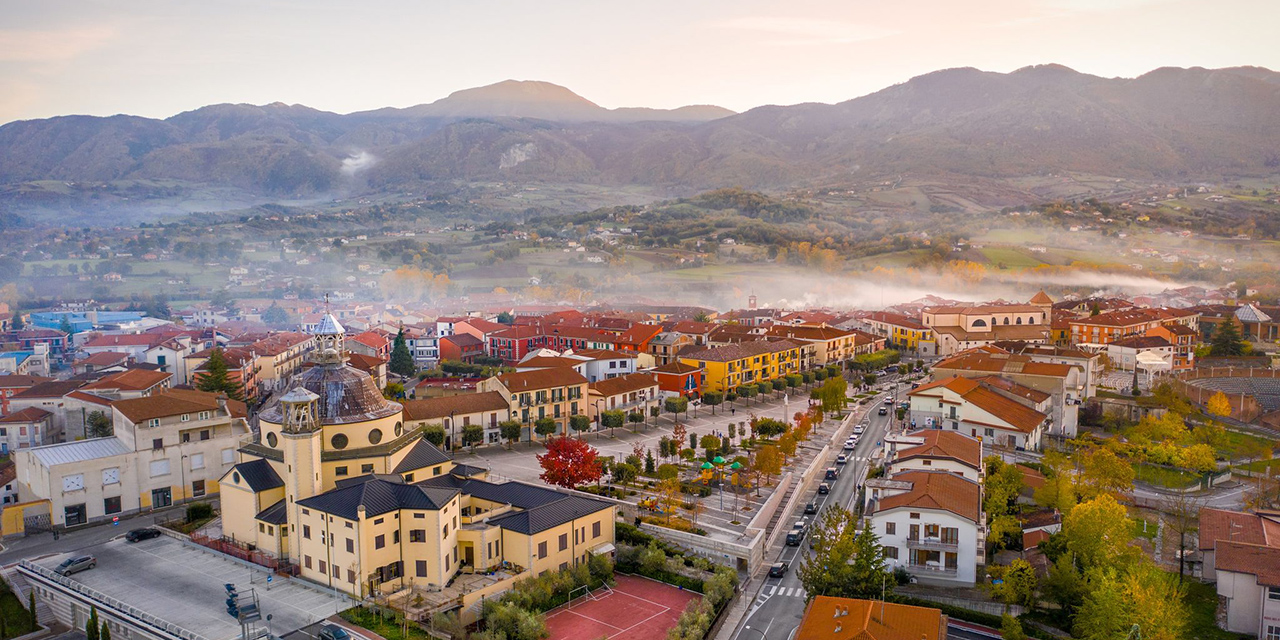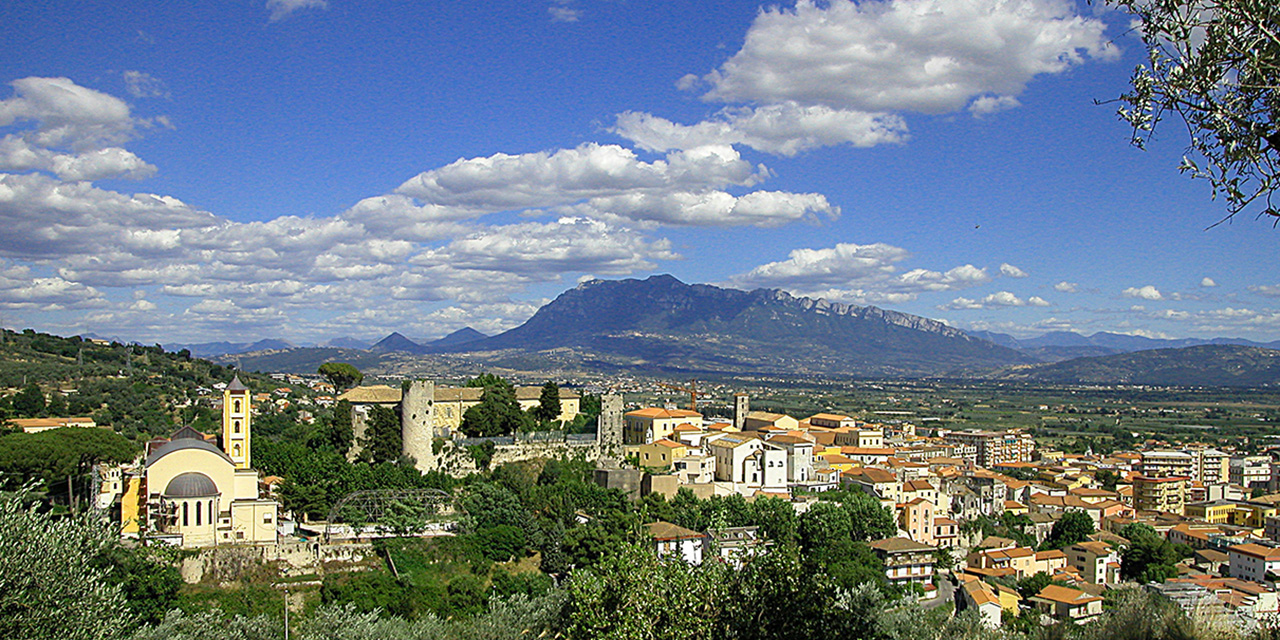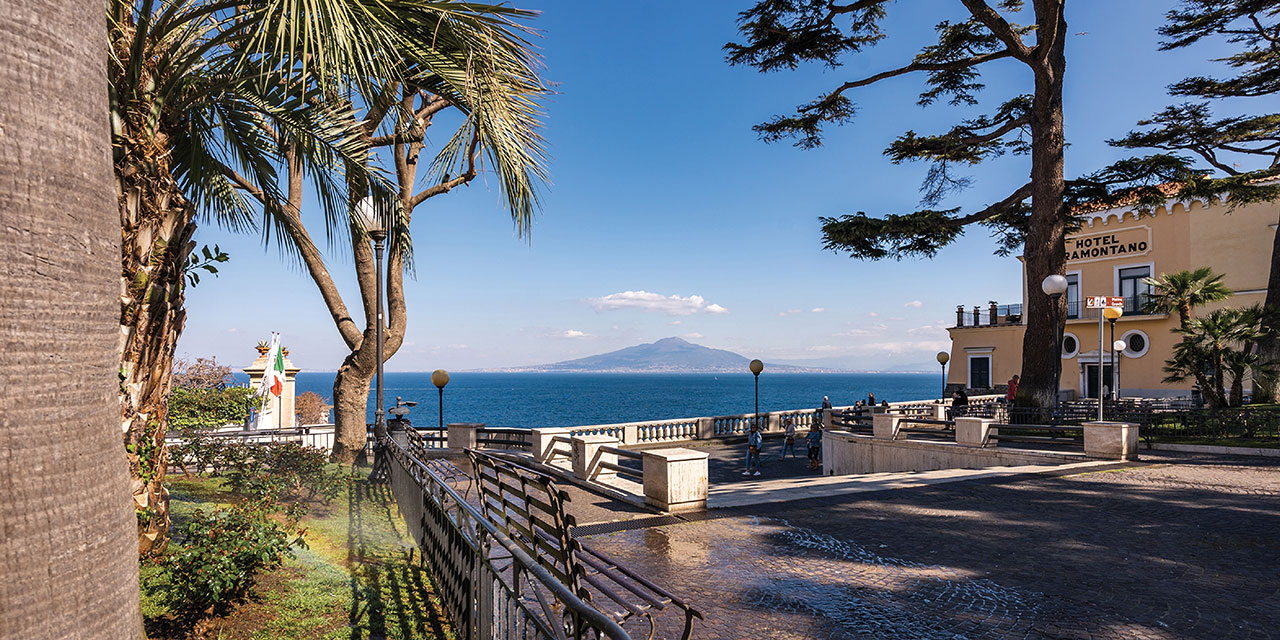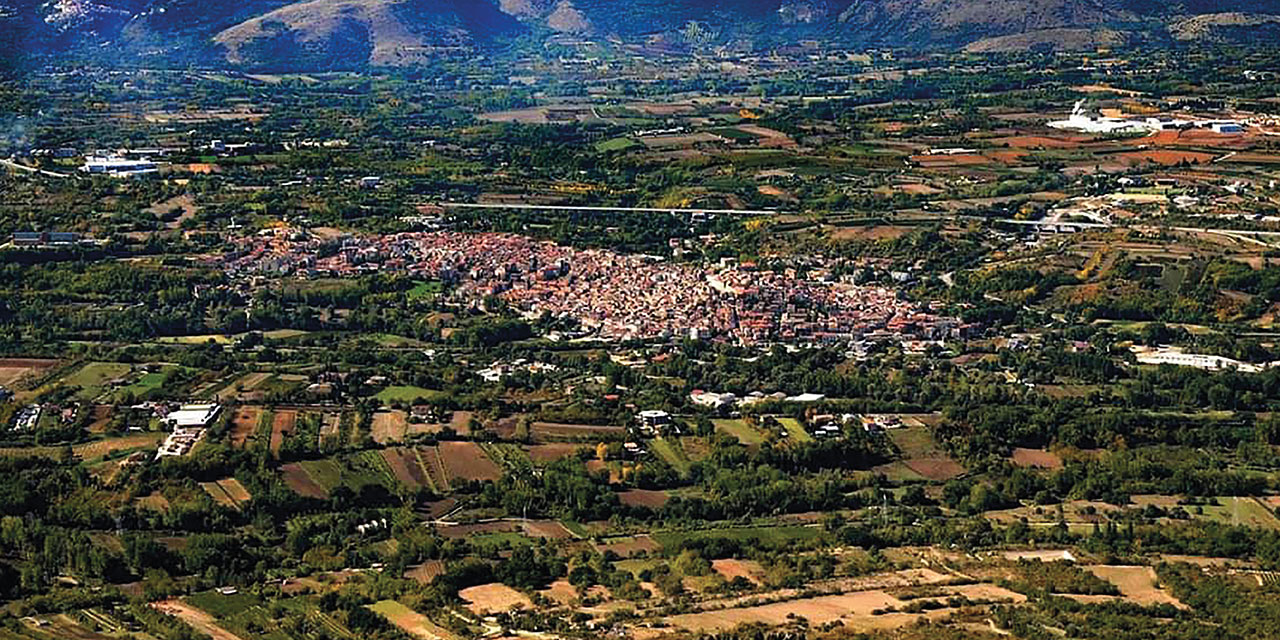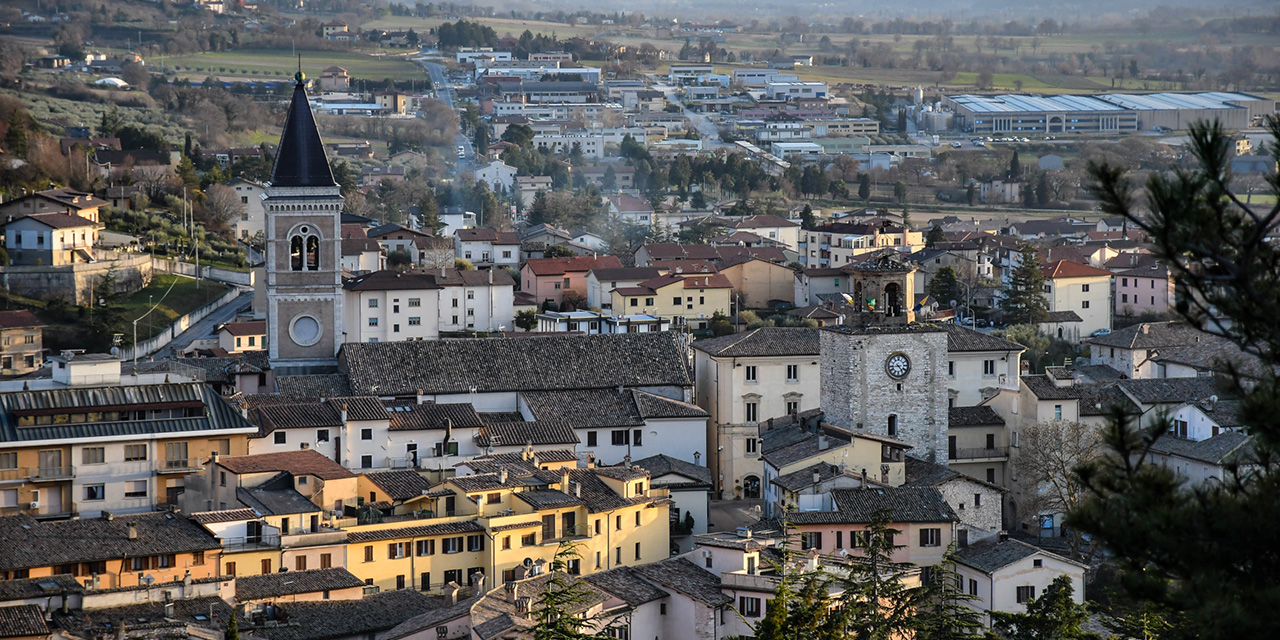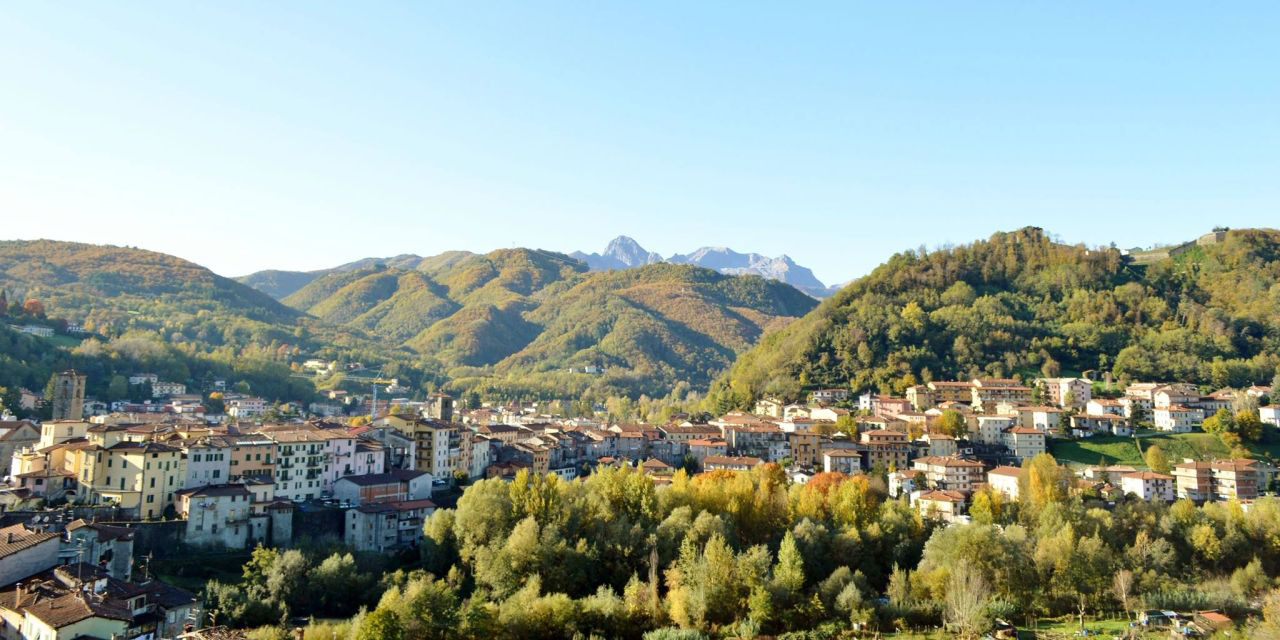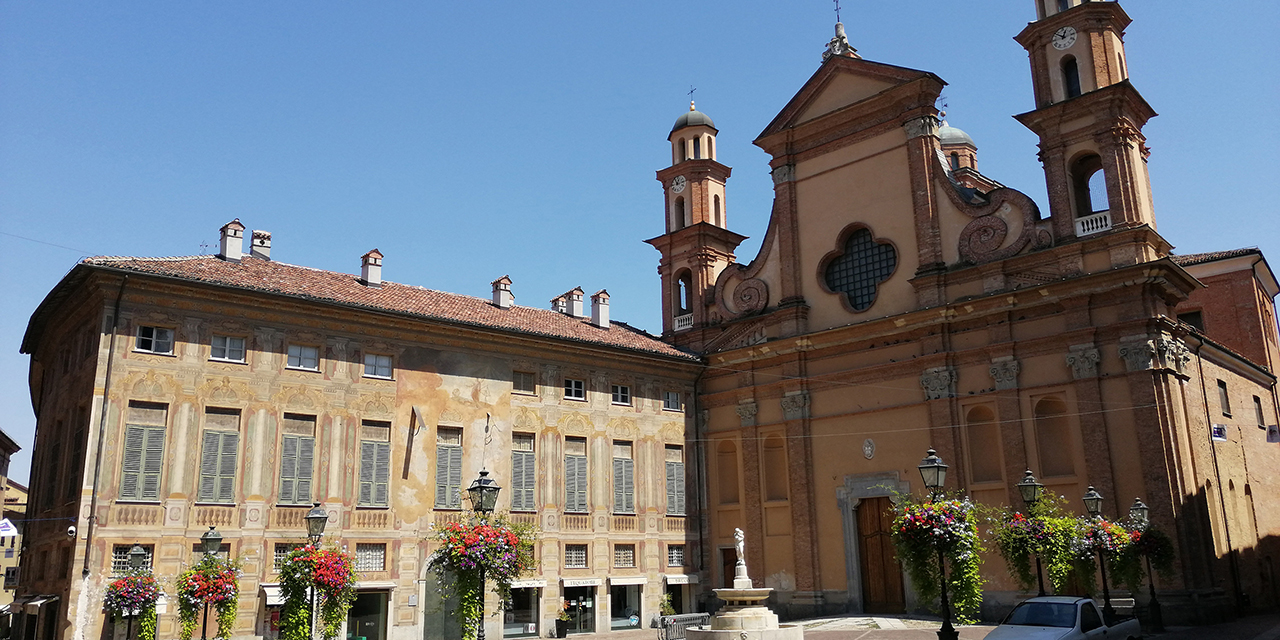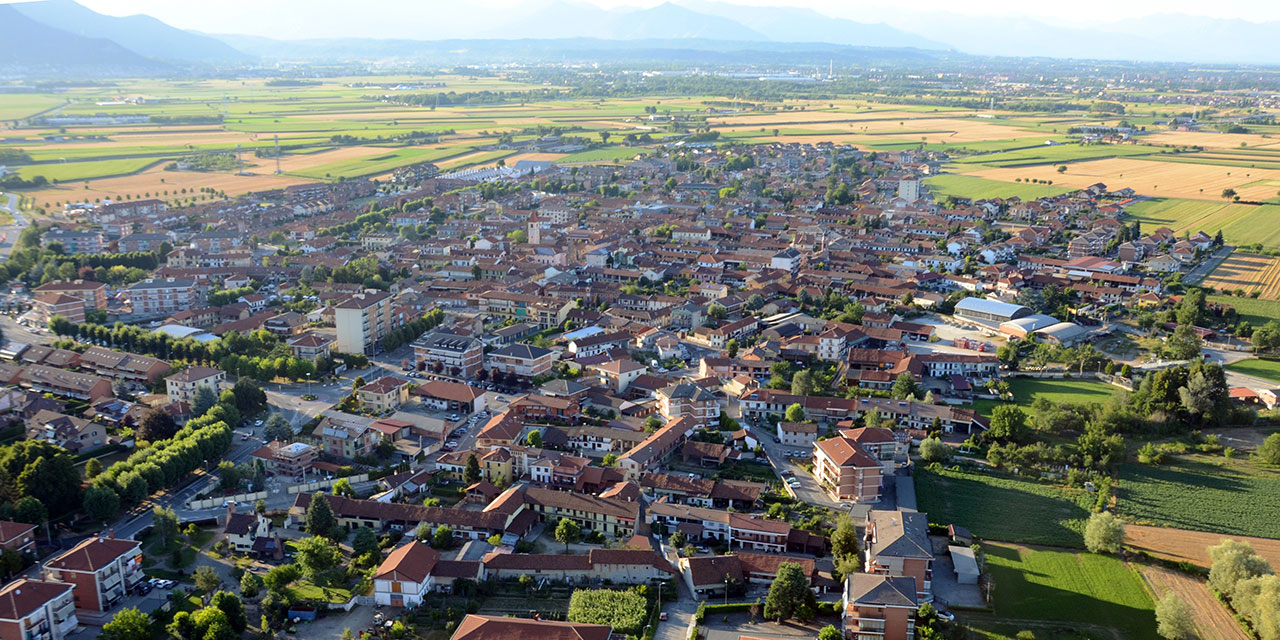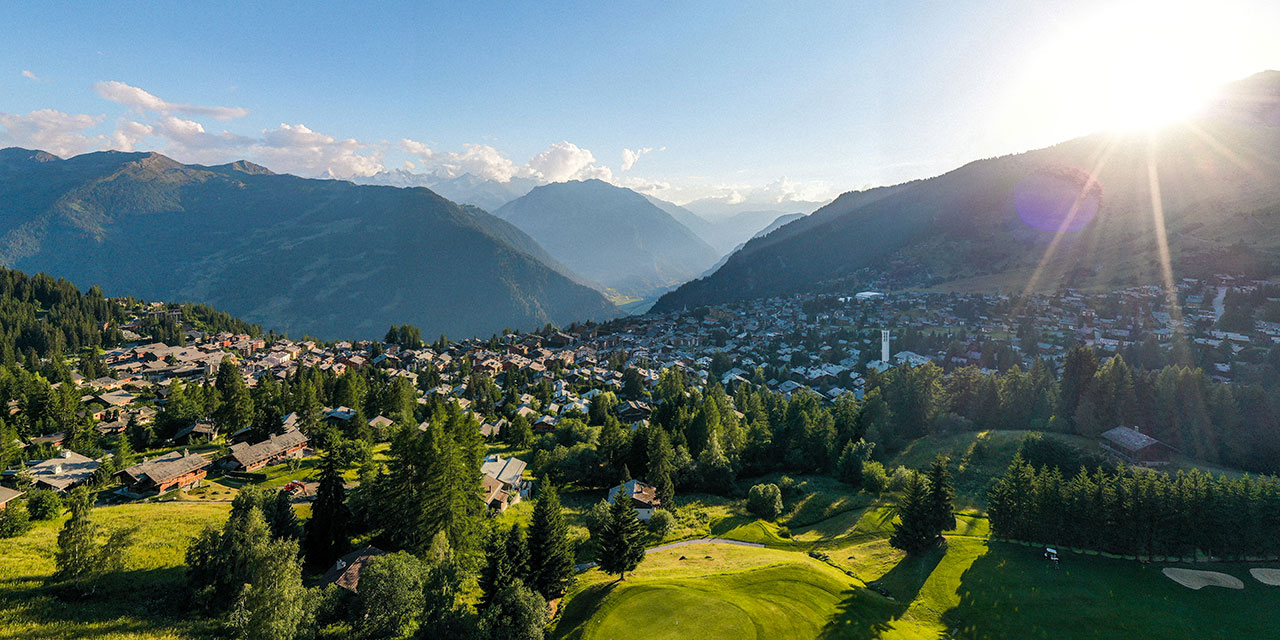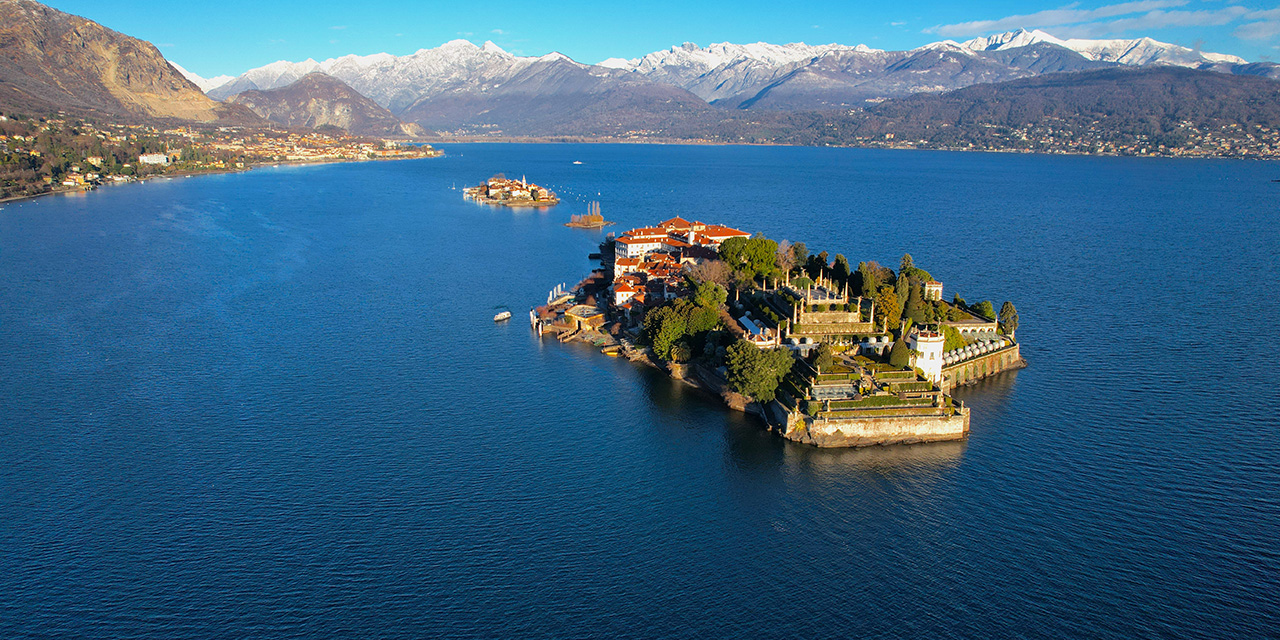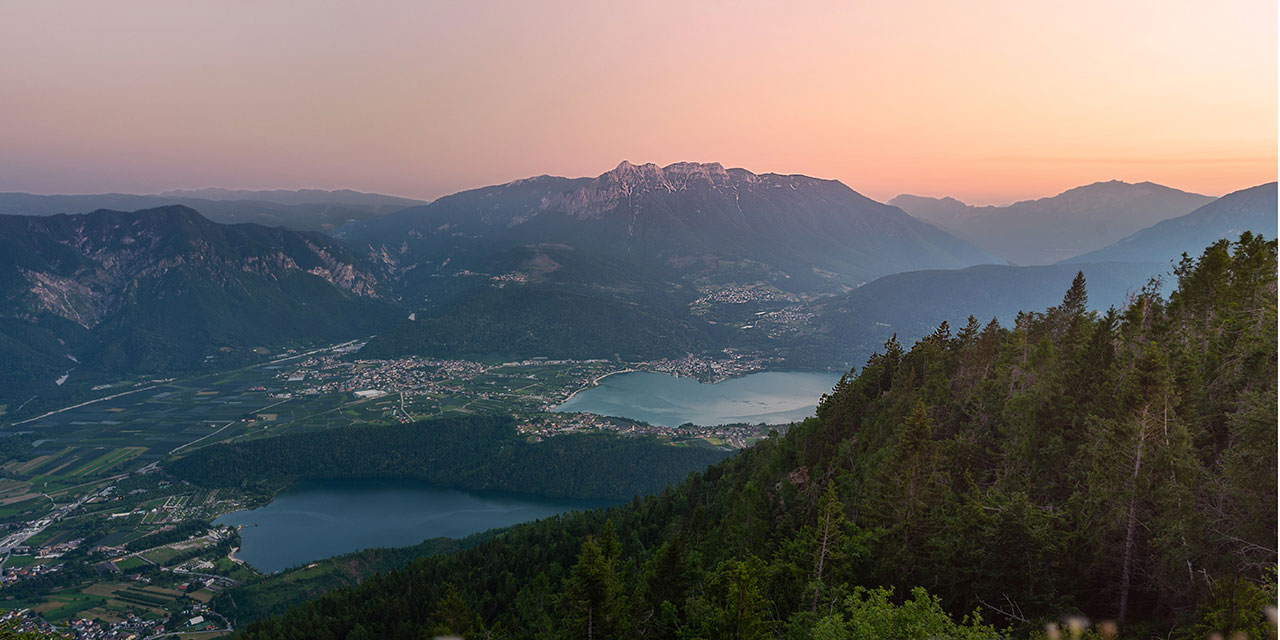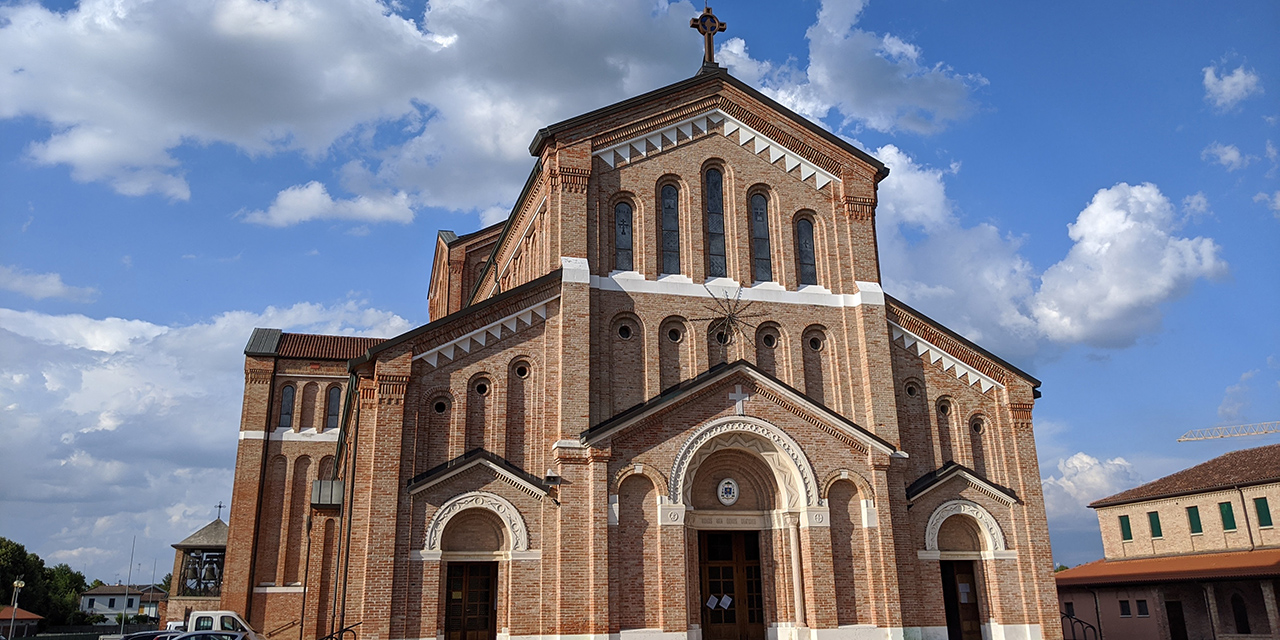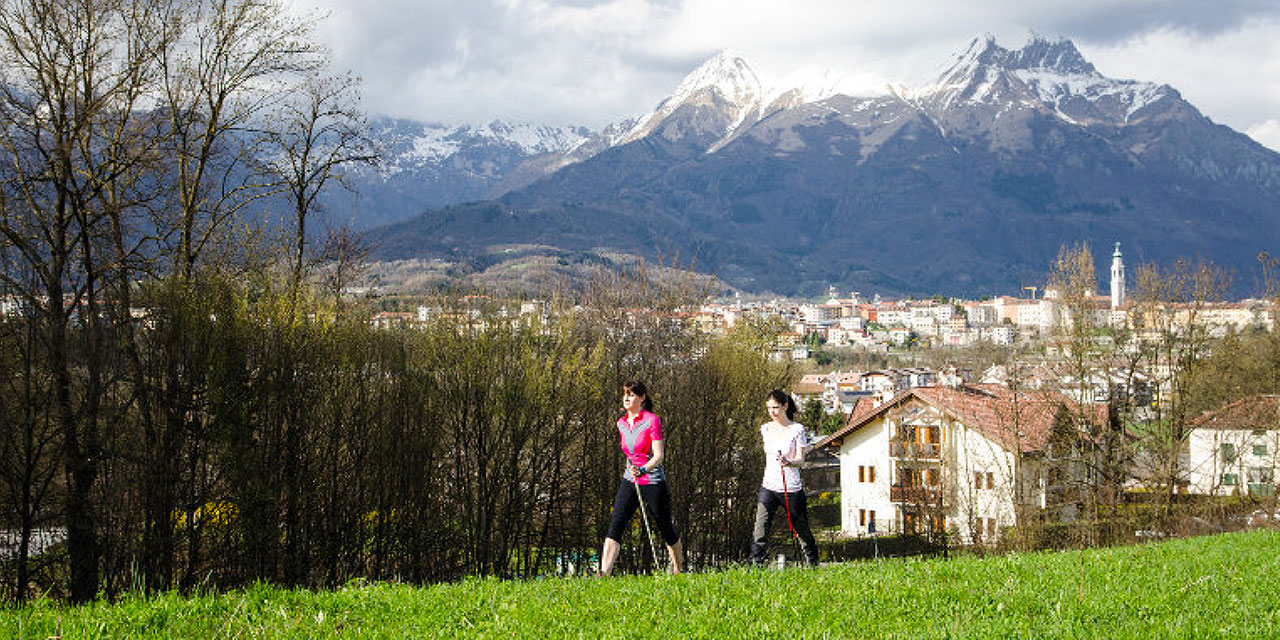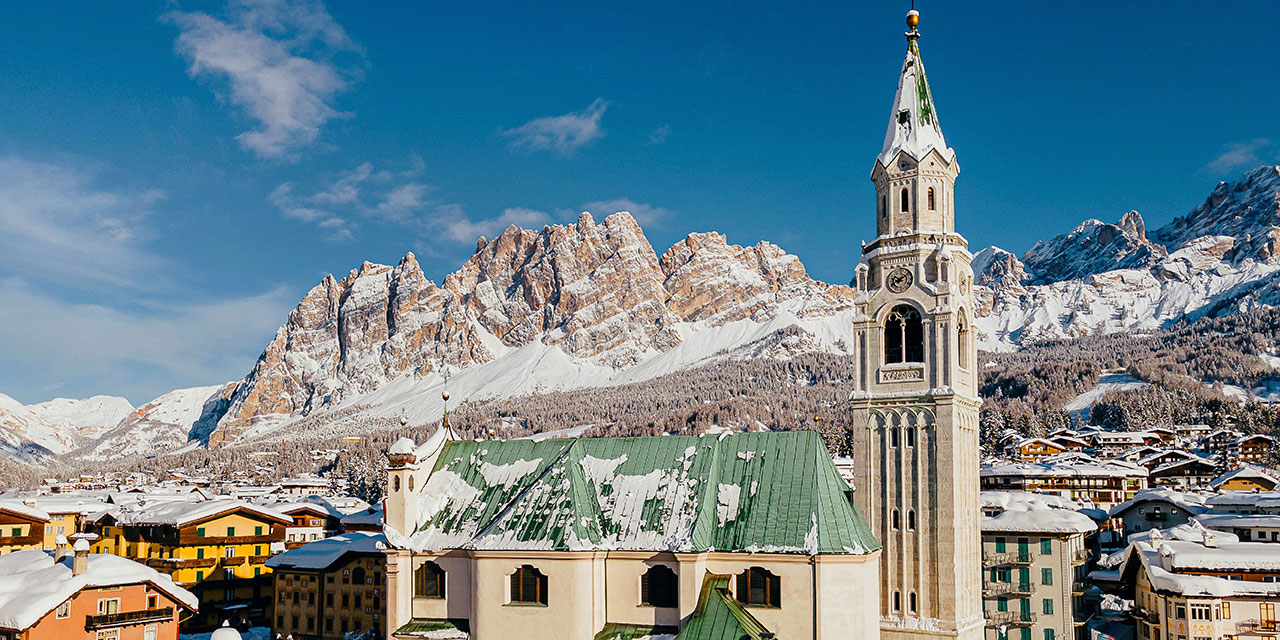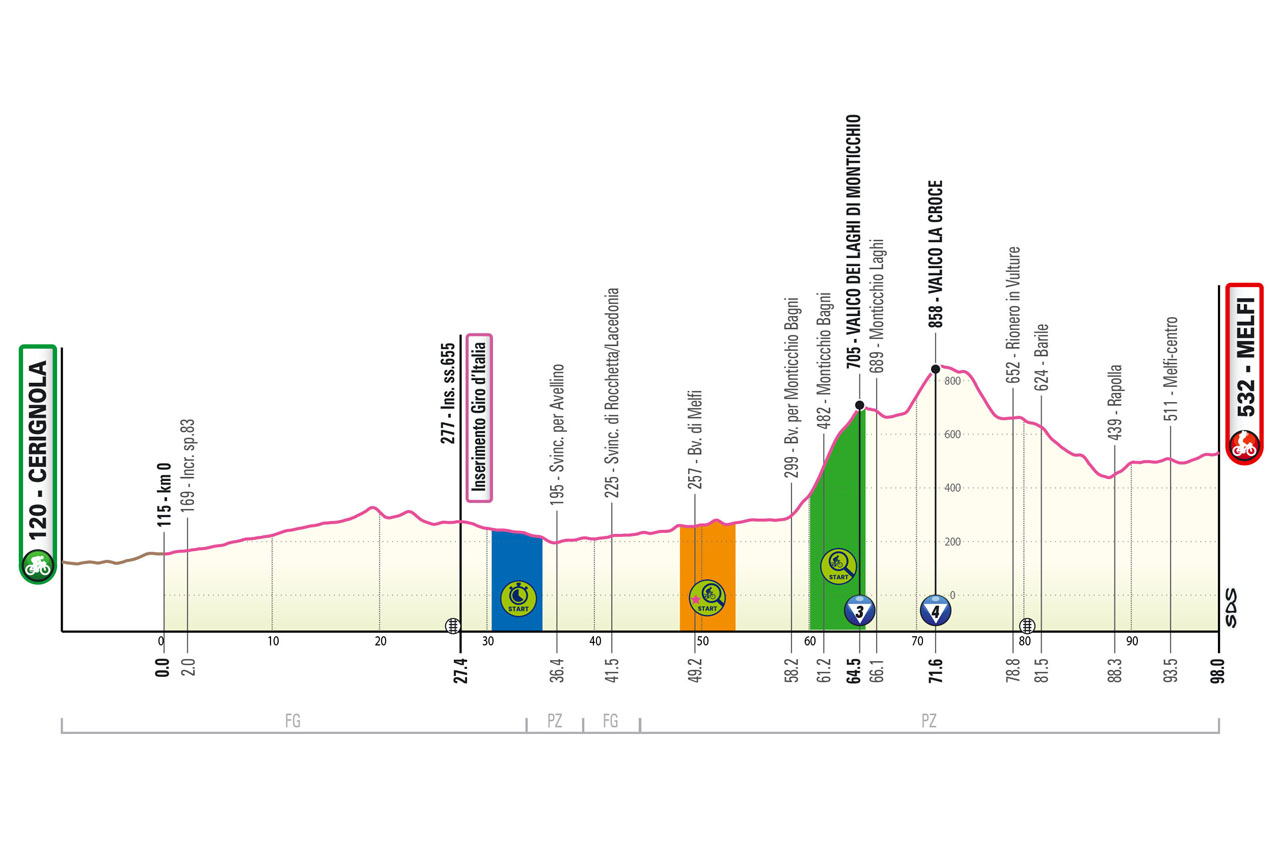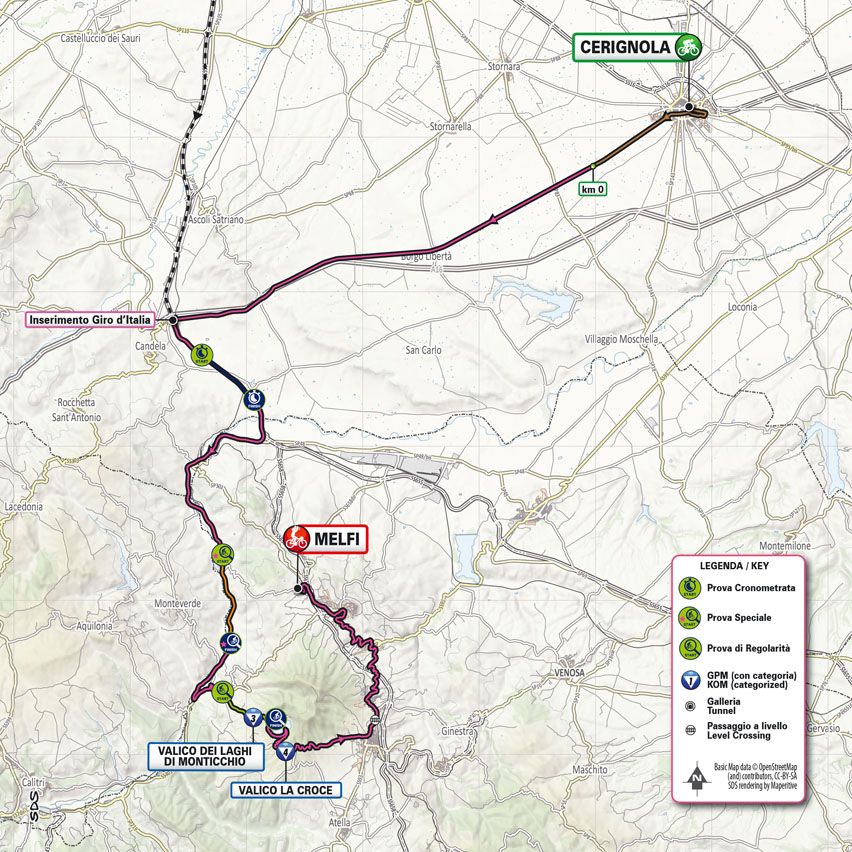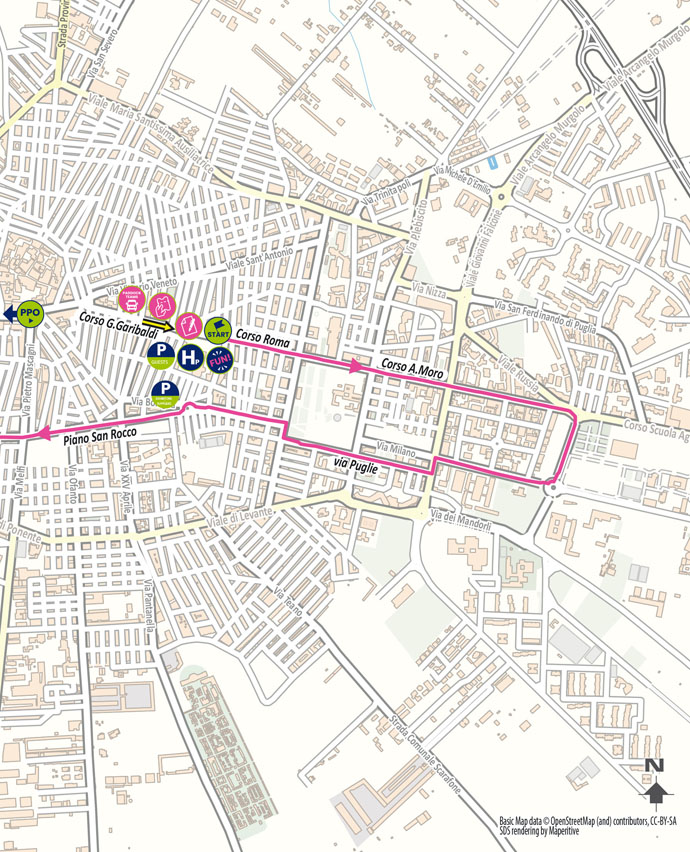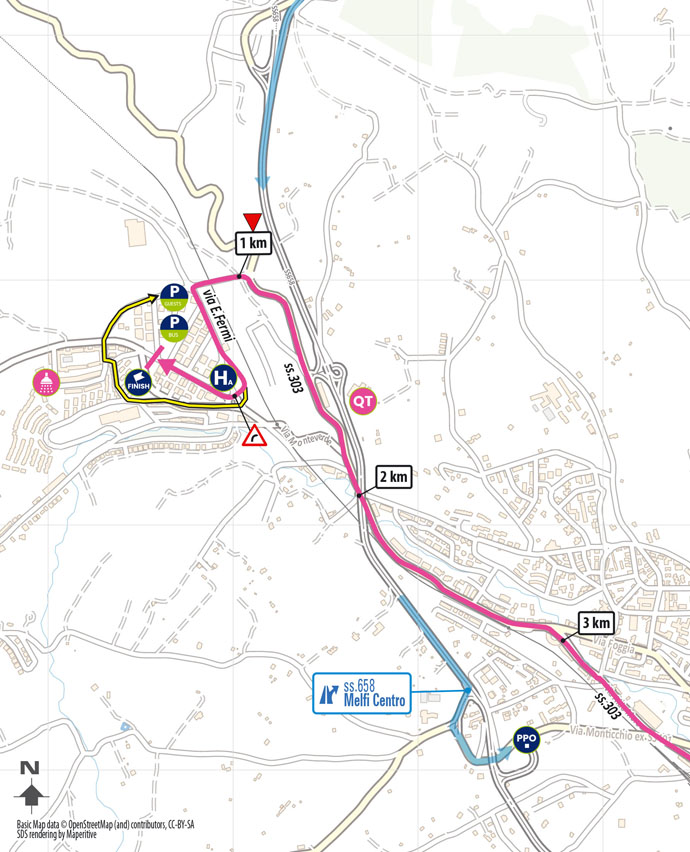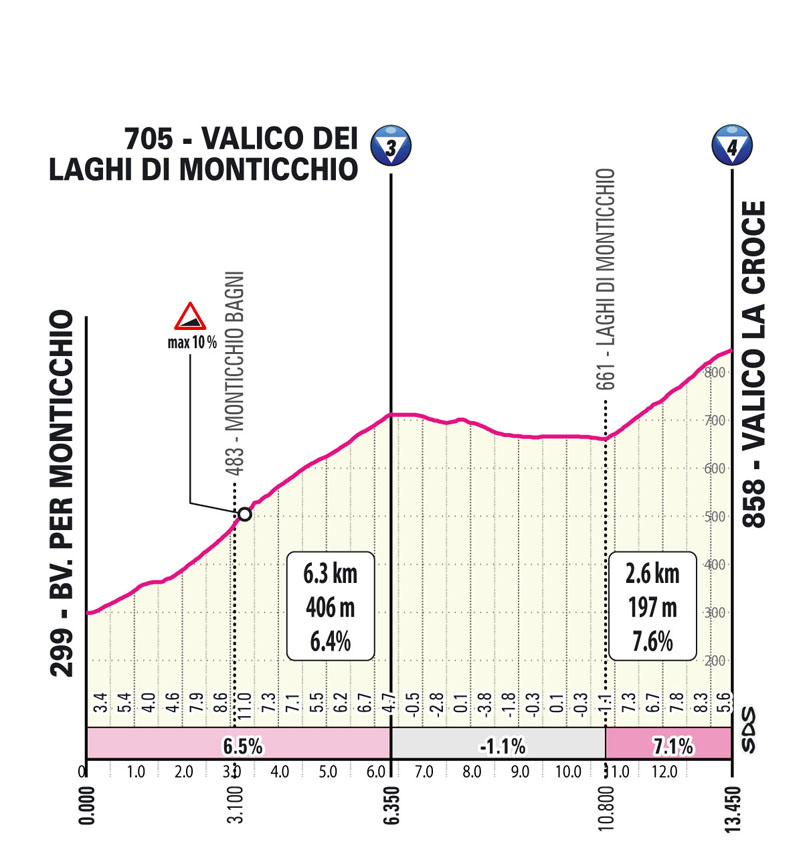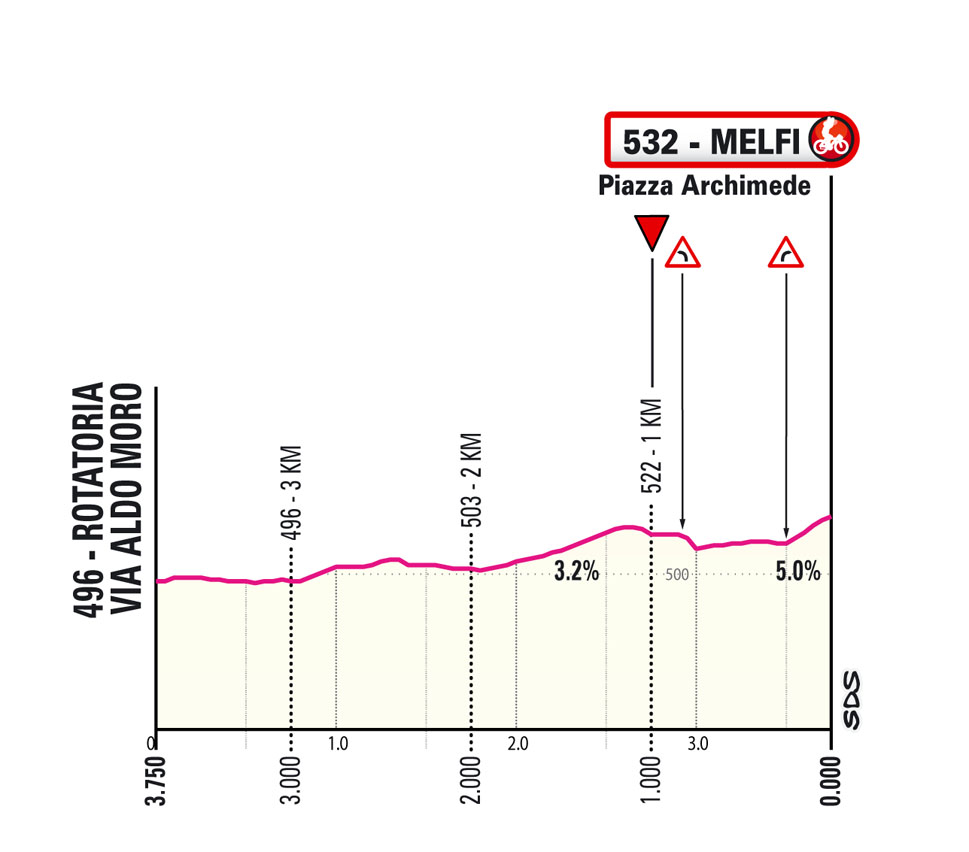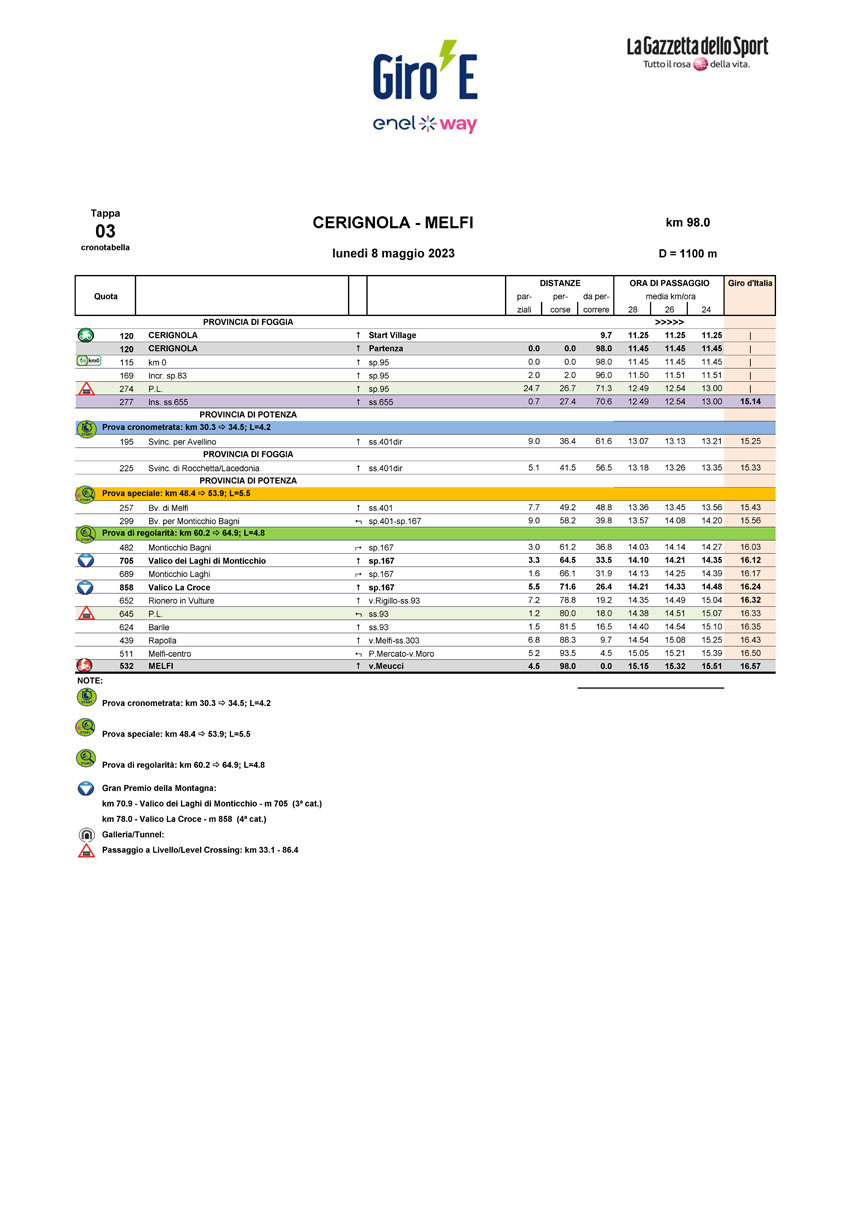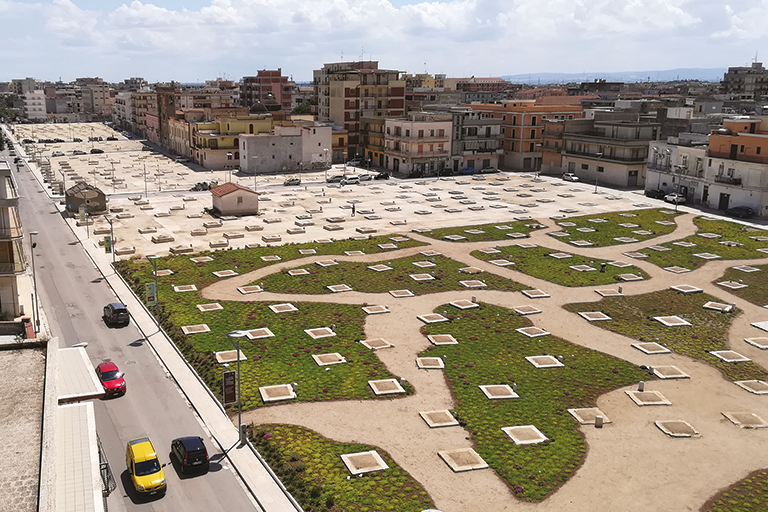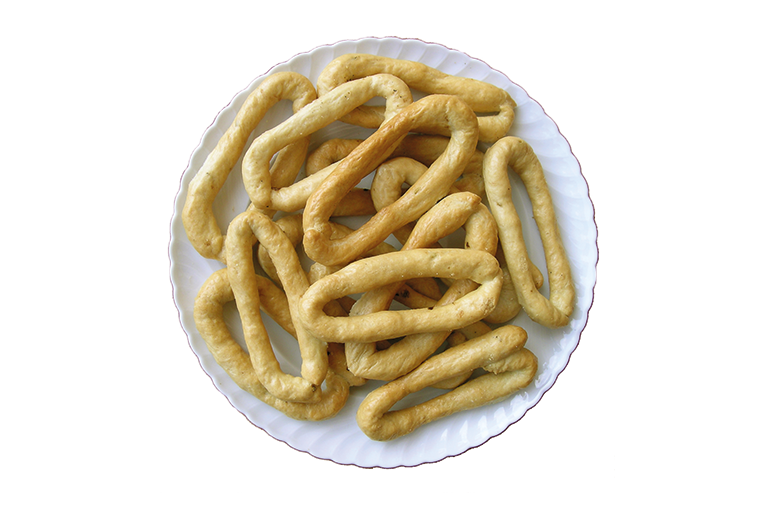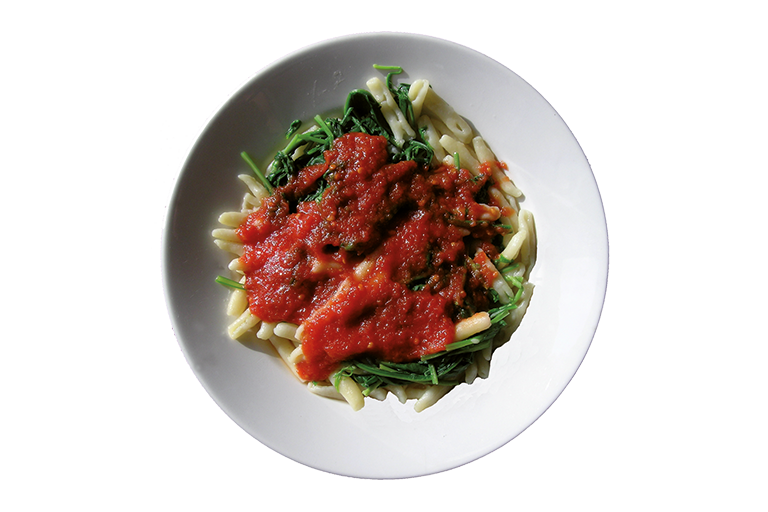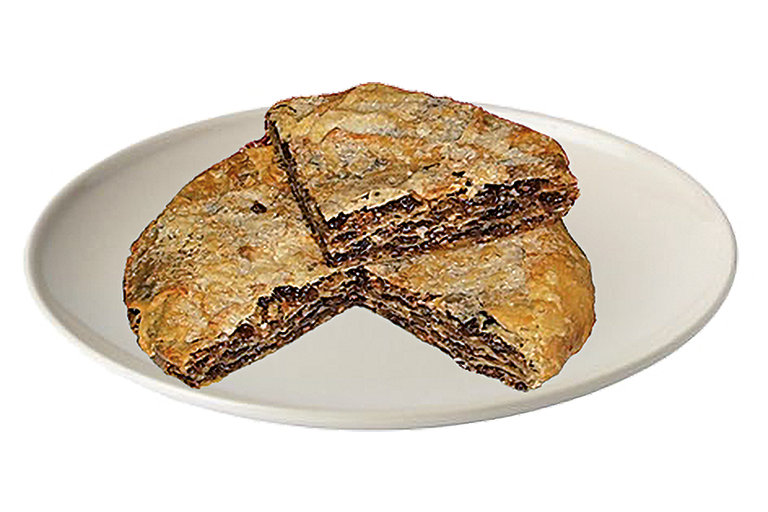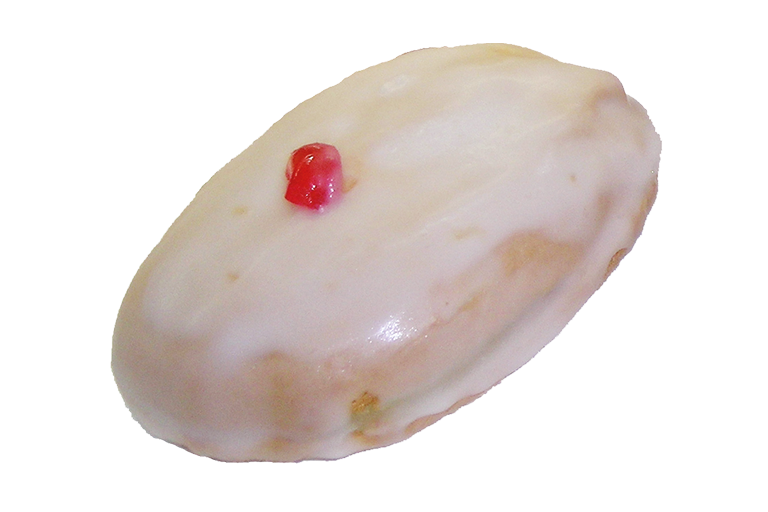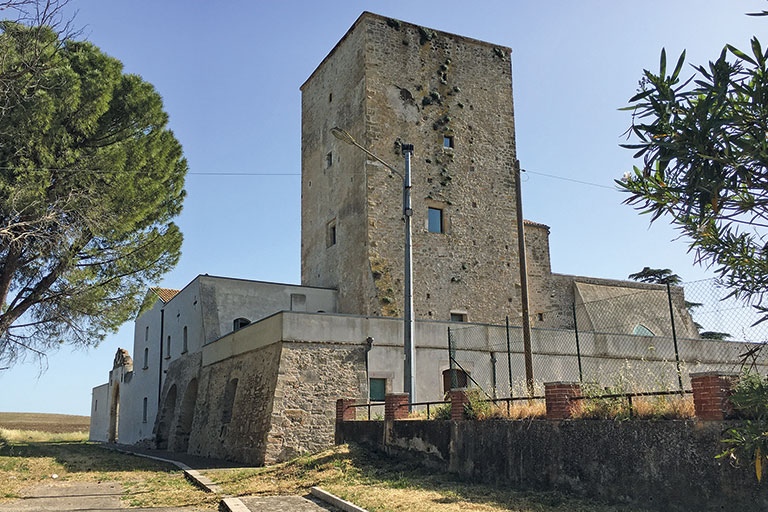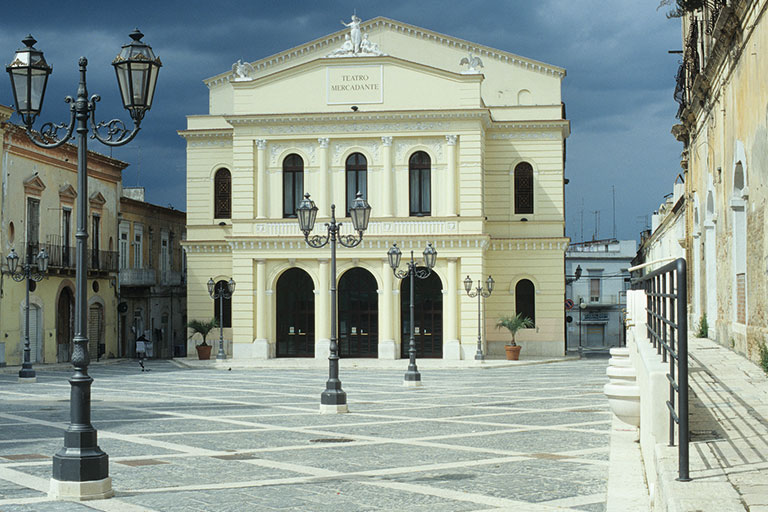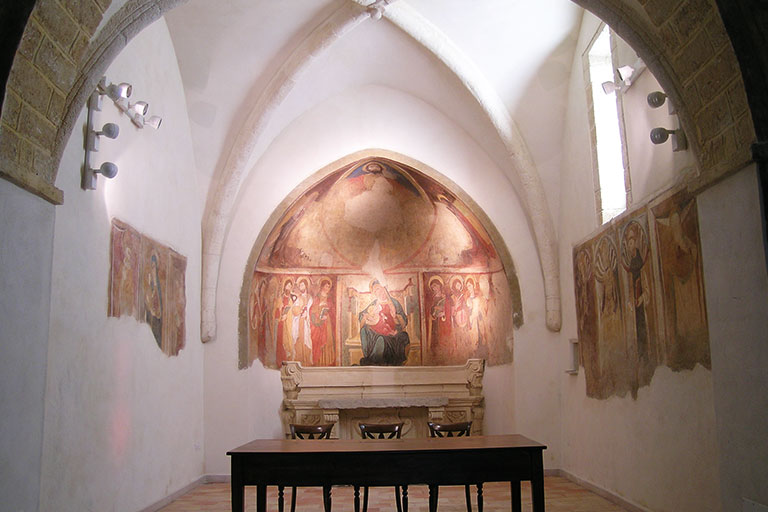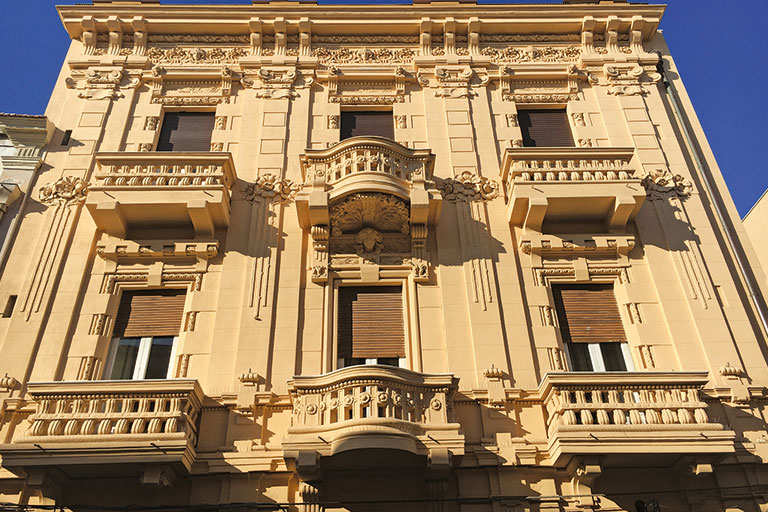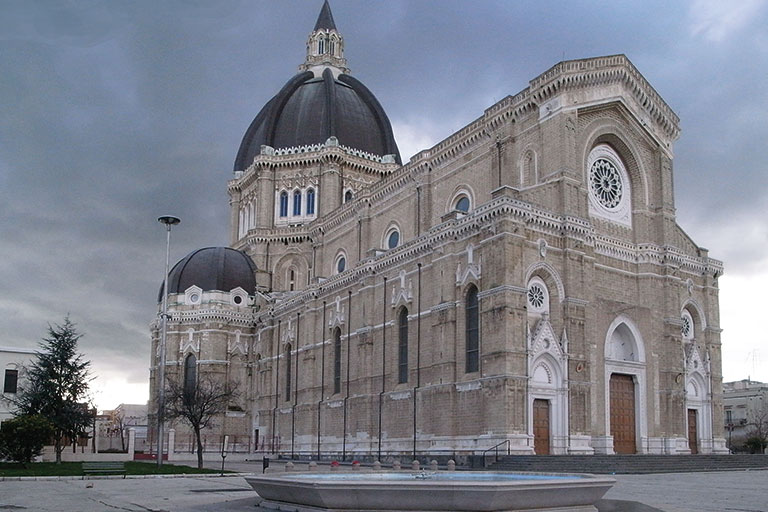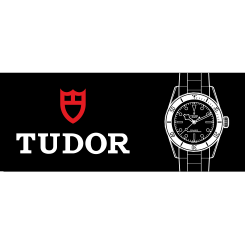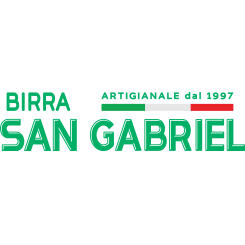profile
map
start / finish
climb detail
final kilometres
itinerary timetable
tourist info
Host city:
CERIGNOLA
Touristic Information
Two ancient itineraries identify the territory of Cerignola between the current Ordona and Canosa; but the first document is from 1225. A fief of the Caracciolo, Pignatelli, Egmont families, it was the scene of the battle of 28 April 1503 between the French and the Spanish. It was the birthplace of Joseph Pavoncelli, Giuseppe Di Vittorio, Nicola Zingarelli.
Lake Capacciotti offers a sporting-naturalistic route in order to arouse interest in eco-sustainable sport and culture. Mountain biking, Yoga, Trekking, running, ecological and botanical walks, walks.
Cerignola is a stop on the “Ciclovia dell’Ofanto” with four itineraries: “From the Daunian mountains to the deep tableland”, “in the mosaic of the Ofanto valley”, “Via della Ripa alta” and “The Norman route. From Melfi to Torre Alemanna”.
Gastronomy
Cavatelli and rocket; burnt wheat cicatelli; orecchiette and turnip greens; presses with meat sauce; cardoncelle and lamb; twists; fried lambs; stuffed peppers; fried cuckoos; warmers; “Bella di Cerignola” olives; artichokes in oil; seven-layer pizza; Cartellate with honey or vincotto; raffaiuoli; grape mustard.
Beverages
Cerignola, at the end of the 20th century, was among the major exporters of wine in Europe through the Pavoncelli and La Rochefoucauld families (at the current Torre Quarto); Red of Cerignola DOC; Nero of Troy; Negramaro; Mistella.
Main sights
Plan of the grain pits; medieval village with the Mother Church; Reitani Palace; Coccia Palace; Tonti Cathedral; Mercadante Theater; Church of S. Maria delle Grazie; Sanctuary of Ripalta (10 km away); Torre Alemanna (at 17 km), Lago Capacciotti (17 Km).
Cerignola is also included in the route of the Via Appia and the Via Francigena.
MELFI
Overview
Melfi is not a city with a simple history, but, above all, it is a city with a beautiful history.
Melfi is the third municipality in Basilicata in terms of population and size.
It develops at an altitude of 562 metres above sea level on Mount Vulture slopes (1327 m. asl)
Its extended historic centre and city walls surrounds the Norman Swabian Castle, first built by the Normans, and then rebuilt by Frederick II. Finally, it was equipped with new towers by Charles I of Anjou and restored by the Caracciolos and Dorias.
Massimo Pallottino (who was born in Melfi) National Archaeological Museum, is based in the Castle and it is one of the most significant and well-known in the south of Italy.
The following historical landmarks and beautiful natural areas stand out among those in Melfi that can be fully appreciated and as well as easily visited:
A well-known symbol of the city and a major tourist attraction is made up of the CATHEDRAL, the BELL TOWER of RUGGIERO II, and the EPISCOPIO.
One of the six entrances that were originally open in Melfi’s walls is known as THE VENOSINA DOOR because it was the starting place of a way that developed from the Via Appia to Venosa. Frederick II walked into the city from this location.
MONTICCHIO LAKES are two beautiful bodies of water surrounded by woods in the far reaches of Mount Vulture.
This fascinating combination of structures and natural wonders contrasts sharply with a sizeable, outlying industrial area where major global companies like Stellantis (formerly Fiat), Barilla, and others have their headquarters.
Food
The entire Vulture-Melfi community is intimately connected to its “chestnut”, which has been celebrated in Melfi since 1960 in all of its forms during the “Varola festival”, unquestionably one of the most significant and enduring gastronomic gatherings in the Lucan culture. It’s an annual tradition that takes place the last weekend in October. Here, the “marroncini” (little chestnuts) are transformed into tasty roast chestnuts since they are prepared and roasted in a huge traditional pan, known as “Varola”.
Accordingly, the Melfi “marroncino” is highly regarded in the creation of desserts, confections, and liquors. It is sought-after for the production of the renowned marron glacé, due to its round shape and unique texture.
The extra virgin olive oil known as Vulture DOP is made from cold-pressed, top-quality olives and it is always the basis of every dish. The most widespread olive quality is “Vulture Ogliarola” along with “Melfi Cima”.
The Vulture-Melfi area is the cradle of the famous Vulture Aglianico wine, made from ruby-colored, DOCG-certified Aglianico grapes.
It is one of the best Italian wines and it has been denominated the “Barolo of the South” due to its method of production and flavour.
Gastronomic specialties
“Pancotto alla Melfitana”: it is prepared by mixing bread, potatoes, and boiled turnips in one saucepan to be finally topped with an oil, garlic, red pepper sauté.
“Cucinidd”: lamb cooked with bacon, sausage, tomatoes, cardoons, and eggs.
“Maccuarnar”: dialect name for “Maccoronara”, which is long, fresh pasta that is hand-made using a metal rolling pin.
“Calzoncelli“: a traditional Melfi dessert. The recipe has been passed down through generations: a cylindrical dough of two to three cm in diameter made of almonds, chocolate, and sugar is coated in a crumbly shortcrust pastry crust.
Points of Interest
MELFI CATHEDRAL
The Cathedral was recently restored on the facade and given new outside lighting. It is the true beating heart of Melfi. It was built starting from its original structure and supervised by Roberto “the Guiscardo”.Then, it was named as “Santa Maria Assunta” despite not having been completed. The interior is divided into three naves by two rows of square-base columns, from which the origins of five arches can be traced. The floor is made of marble and hard stones placed in rhombic patterns. The side aisles have a vaulted ceiling while the central one has a false ceiling in gilded wooden coffers made in the 18th century by Bishop Spinelli who had his coat of arms affixed in the center. Behind the main altar, there is the presbytery and a wooden choir dating back to the 1500s. Surmounting the choir, there is a pipe organ from the 1700s.
RUGGERO II BELL TOWER
Ruggero II commissioned Noslo de Remerio to complete the Norman building in 1153, and today only the magnificent bell tower is visible. With a square plan measuring 9.25 metres on each side, three floors, and a terminal pyramid, it rises to a height of around 61 metres and, from a distance, resembles a massive tower defending the city. On the frame of the third floor, Federico II had the Ghibelline merlons put down after 1851 by order of Bishop Sellitti. An octagonal prism that rests above the third level serves as the base for a pyramid that takes the place of the original circular dome typical of Norman-Arab buildings.
BISHOP’S PALACE
The Hall of Coats of Arms of the “Episcopio” in Melfi is certainly the place of the highest prestige that our city offers, for the simple fact that on its walls is narrated the history, not only religious, of the Regio Vulturis of Bertauxiana memory through the bishops’ coats of arms who animated it. The “Episcopio” is unquestionably among the first and the best structure in the Kingdom, and may still be unequalled, with its long facade, grandiose courtyard, towering staircase, vast halls, and adorned rooms. Tourists can admire then the large enclosed garden commissioned by Bishop Mario Rufino, the Bishop Basta-designed coat-of-arms hall, the throne room, with frescoed walls, the late 18th-century fountain that adorns the internal courtyard, and the wide scissor staircase that is reminiscent of Neapolitan noble palaces. The inside of the halls today serves as a fascinating art gallery with sacred vestments, as well as paintings of religious and secular subjects ranging from the school of Nicola da Tolentino, attested to the 15th century, to works by Cristiano Danona.
THE VENOSINA DOOR
The Venosina Dorr, one of the six former open gates in Melfi’s walls, is where Frederick II entered the city. It was the starting point of an artery that extended through the Via Appia to Venosa. The battle between Charles V’s German-Spanish Empire and the French Capetian Kings, which took place in Melfi between March 22, 1528, and November 5, 1528, is reenacted there during the feast of Pentecost.
THE NORMAN SWABIAN CASTLE
The Norman Swabian Castle was built by the Normans, rebuilt by Frederick II, equipped with new towers by Charles I of Anjou, and restored by the Caracciolos and the Dorias. Despite having the appearance of a fortress, it is unquestionably not an example of unitary architecture. It is without a doubt the most well-known and one of the biggest castles in Basilicata and in the south of Italy. It comprises 10 towers, seven of which are rectangular and three pentagonal, and it is built on top of a hill, surrounded by a rampart, a moat, and a wall. There are four entrances, three of which are Angevin. Beyond the front door, you enter the Main Courtyard overlooked by the baronial palace and the noble chapel and immediately after, you can see an arch that connects the palace to the church, to the courtyard (also known as “Cortile della Rimessa”) and the Cistern. Finally, the “Cortile del Mortorio” is located between the tower of the Emperor and the Torrita Parvula. Armigeri Square is located between the “Baluardo del Leone” and the Emperor’s tower. Two square towers can be seen and they were built into the central complex’s two front ends; a third tower was at the opposite corner but there is no trace today. The window in the Throne Room, the Marcangione tower’s mullioned window motif, which is evocative of the Termoli cathedral’s facade, and the capital of the bastion, which is centred on a spiral staircase connecting the North East tower and the Prisons tower, all have architectural significance. The latter capital is similar to those found in “Castel del Monte.”
THE ROCKY CHURCH OF SANTA MARGHERITA
SANTA MARGHERITA church, which dates to the year 1200 and was totally excavated in tuff, is the most organic-looking from a structural perspective among the rock churches. It was found by Gian Battista Guarini and has a single nave with frescoes on every wall but those near the apse. The apse vault features a portrait of Christ Pantocrator in addition to the Archangel Michael, the Madonna with Child, St. John the Baptist, Christ Enthroned, St. Basil, and St. Nicholas. Three lay people dressed as falconers are portrayed in the chapel as well.
The three laymen would be the members of the Swabian imperial family, according to a 1993 theory developed by a Neapolitan named Raffaele Capaldo: Corrado, the son of Frederick II, the emperor and his wife Elizabeth of England, would be dressed as falconers as Federico, since people who attended church were accustomed to seeing him in hunting clothing.


